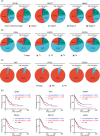Cancer-associated fibroblasts in nonsmall cell lung cancer: From molecular mechanisms to clinical implications
- PMID: 35603909
- PMCID: PMC9545594
- DOI: 10.1002/ijc.34127
Cancer-associated fibroblasts in nonsmall cell lung cancer: From molecular mechanisms to clinical implications
Abstract
Lung cancer is the common and leading cause of cancer death worldwide. The tumor microenvironment has been recognized to be instrumental in tumorigenesis. To have a deep understanding of the molecular mechanism of nonsmall cell lung carcinoma (NSCLC), cancer-associated fibroblasts (CAFs) have gained increasing research interests. CAFs belong to the crucial and dominant cell population in the tumor microenvironment to support the cancer cells. The interplay and partnership between cancer cells and CAFs contribute to each stage of tumorigenesis. CAFs exhibit prominent heterogeneity and secrete different kinds of cytokines and chemokines, growth factors and extracellular matrix proteins involved in cancer cell proliferation, invasion, metastasis and chemoresistance. Many studies focused on the protumorigenic functions of CAFs, yet many challenges about the heterogeneity of CAFS remain unresolved. This review comprehensively summarized the tumor-promoting role and molecular mechanisms of CAFs in NSCLC, including their origin, phenotypic changes and heterogeneity and their functional roles in carcinogenesis. Meanwhile, we also highlighted the updated molecular classifications based on the molecular features and functional roles of CAFs. With the development of cutting-edge platforms and further investigations of CAFs, novel therapeutic strategies for accurately targeting CAFs in NSCLC may be developed based on the increased understanding of the relevant molecular mechanisms.
Keywords: cancer-associated fibroblast; heterogeneity; nonsmall-cell lung cancer; tumor microenvironment.
© 2022 The Authors. International Journal of Cancer published by John Wiley & Sons Ltd on behalf of UICC.
Conflict of interest statement
The authors declare that they have no conflict of interest.
Figures



Similar articles
-
Cancer-associated fibroblasts in non-small cell lung cancer: Recent advances and future perspectives.Cancer Lett. 2021 Aug 28;514:38-47. doi: 10.1016/j.canlet.2021.05.009. Epub 2021 May 18. Cancer Lett. 2021. PMID: 34019960 Review.
-
Characterization of Distinct Populations of Carcinoma-Associated Fibroblasts from Non-Small Cell Lung Carcinoma Reveals a Role for ST8SIA2 in Cancer Cell Invasion.Neoplasia. 2019 May;21(5):482-493. doi: 10.1016/j.neo.2019.03.009. Epub 2019 Apr 9. Neoplasia. 2019. PMID: 30978569 Free PMC article.
-
Chemotherapy-induced PDL-1 expression in cancer-associated fibroblasts promotes chemoresistance in NSCLC.Lung Cancer. 2023 Jul;181:107258. doi: 10.1016/j.lungcan.2023.107258. Epub 2023 May 22. Lung Cancer. 2023. PMID: 37245409 Free PMC article.
-
Cancer-associated fibroblasts and the tumor microenvironment in non-small cell lung cancer.Expert Rev Anticancer Ther. 2022 Feb;22(2):169-182. doi: 10.1080/14737140.2022.2019018. Epub 2022 Jan 2. Expert Rev Anticancer Ther. 2022. PMID: 34904919
-
Crosstalk between cancer-associated fibroblasts and immune cells in the tumor microenvironment: new findings and future perspectives.Mol Cancer. 2021 Oct 11;20(1):131. doi: 10.1186/s12943-021-01428-1. Mol Cancer. 2021. PMID: 34635121 Free PMC article. Review.
Cited by
-
Cancer-associated fibroblasts in early-stage lung adenocarcinoma correlate with tumor aggressiveness.Sci Rep. 2023 Oct 17;13(1):17604. doi: 10.1038/s41598-023-43296-3. Sci Rep. 2023. PMID: 37848457 Free PMC article.
-
Musashi-2 in cancer-associated fibroblasts promotes non-small cell lung cancer metastasis through paracrine IL-6-driven epithelial-mesenchymal transition.Cell Biosci. 2023 Nov 8;13(1):205. doi: 10.1186/s13578-023-01158-5. Cell Biosci. 2023. PMID: 37941042 Free PMC article.
-
Leveraging an immune cell signature to improve the survival and immunotherapy response of lung adenocarcinoma.J Cancer. 2024 Jan 1;15(3):747-763. doi: 10.7150/jca.90515. eCollection 2024. J Cancer. 2024. PMID: 38213728 Free PMC article.
-
Paracrine Regulation and Immune System Pathways in the Inflammatory Tumor Microenvironment of Lung Cancer: Insights into Oncogenesis and Immunotherapeutic Strategies.Cancers (Basel). 2024 Mar 10;16(6):1113. doi: 10.3390/cancers16061113. Cancers (Basel). 2024. PMID: 38539448 Free PMC article. Review.
-
Cancer-associated fibroblast-derived exosomal FAM83F regulates KIF23 expression to promote the malignant progression and reduce radiosensitivity in non-small cell lung cancer.Cytotechnology. 2025 Apr;77(2):50. doi: 10.1007/s10616-025-00713-x. Epub 2025 Jan 25. Cytotechnology. 2025. PMID: 39867833
References
-
- Sung H, Ferlay J, Siegel RL, et al. Global cancer statistics 2020: GLOBOCAN estimates of incidence and mortality worldwide for 36 cancers in 185 countries. CA Cancer J Clin. 2021;71:209‐249. - PubMed
-
- Siegel RL, Miller KD, Fuchs HE, Jemal A. Cancer statistics, 2021. CA Cancer J Clin. 2021;71:7‐33. - PubMed
Publication types
MeSH terms
LinkOut - more resources
Full Text Sources
Medical

